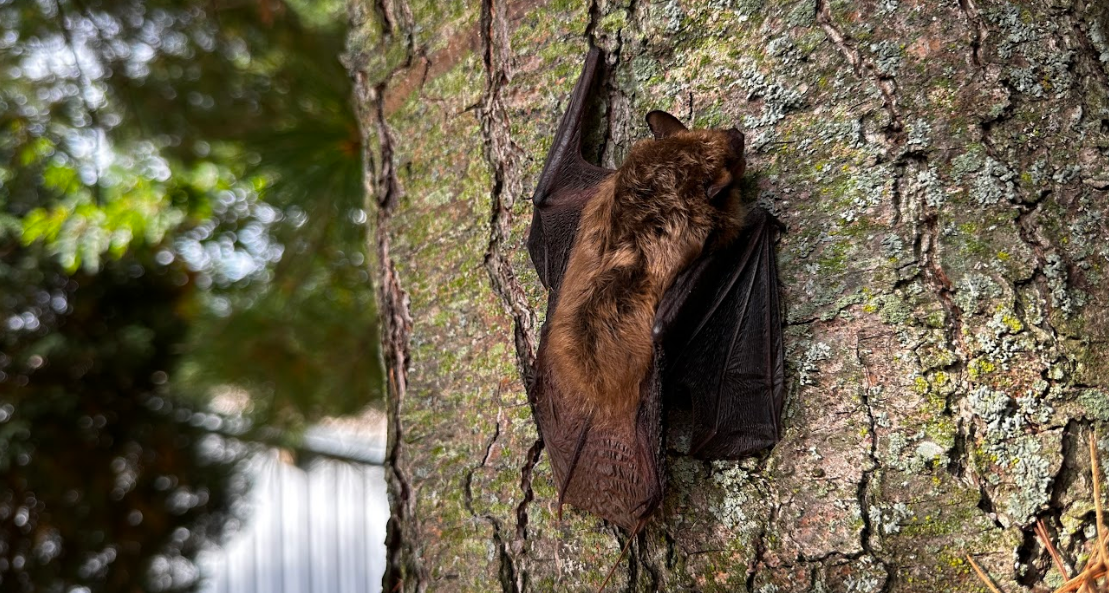BAT REMOVAL PROCESS
Assess and Remove
The key to removing bats from your home is determining their entry points. Bats can enter through small openings and leave very little trace behind. Our expert technicians will identify all the entry points and evict the colony humanely using one-way doors that allow the bats to leave for food but prevent their re-entry.
Clear and Clean
Depending on the size of the colony and how long they’ve been living in the home there could be a large mess to clean up. Our wildlife technicians will thoroughly remove bat guano and disinfect the space to eliminate any harmful traces left behind.
Bats, while essential to our ecosystem, can pose significant challenges when they choose to roost in residential or commercial properties. These nocturnal creatures can create health risks due to the diseases carried in their guano, and loud, persistent noises can disrupt your peace and quiet. This is why efficient and humane bat removal is critical for homeowners and businesses in our area. We understand the importance of preserving bats’ role in nature while ensuring your home remains a safe and comfortable space.
At Skedaddle, we prioritize methods that protect both your property and the local bat populations. Our experienced team employs a strategic approach that ensures bats are safely and humanely excluded, allowing them to find alternative roosts without stress or harm. We also offer property assessments to identify entry points and potential vulnerabilities, providing you with tailored solutions to prevent future bat intrusions. Our commitment to humane, ethical practices sets us apart in the field of bat removal in York Region, delivering peace of mind with every project. We invite you to learn more about our services and how we can help maintain the delicate balance between human habitats and wildlife conservation.
How Bat Behaviours Can Affect Home and Business Owners
Bats are fascinating creatures central to many ecosystems, but their behaviours can present challenges to home and business owners when they decide to roost in buildings. Primarily nocturnal, bats seek out dark, quiet places to colonize during daylight hours, which often leads them to attic spaces, chimneys, or wall voids. Their presence can lead to several issues. A significant concern is the accumulation of guano (bat droppings), which can not only damage structures but also pose health risks. Histoplasmosis, a respiratory disease, can be contracted by inhaling spores from bat guano. Additionally, bats can bring along parasites such as mites, fleas, and ticks, which can then spread to humans or pets.
Furthermore, even though bats rarely have rabies, they are mammals and can contract and transmit the virus, intensifying the importance of preventive measures.
To protect your property from unwanted bat guests, it is crucial to adopt proactive prevention strategies. Regular inspections can help you identify potential entry points, such as unscreened vents or gaps in roofing. We recommend sealing off these openings with professional-grade materials designed to withstand the elements while ensuring the natural ventilation of your building.
Additionally, maintaining a clean and clutter-free attic or storage area will make spaces less inviting to bats searching for a roost. If you suspect bats are trying to enter your building, we at Skedaddle offer professional wildlife removal in York Region, specializing in effective and humane exclusion techniques. Our expert team is dedicated to securing your property while respecting local wildlife, ensuring integrated solutions that protect both your home or business and the bats’ ecological roles.
How to Get Rid of Bats: Skedaddle‘s Humane Process
At Skedaddle, our humane removal process begins with a thorough inspection of your property. We assess the entire building to locate bat entry points and identify the specific species involved, understanding their behaviour and habits. This critical step informs our strategic plan to ensure effective and humane exclusion. During this phase, we take care to be minimally invasive, respecting both your property and the needs of the bats.
Next, we implement an exclusion strategy designed to allow bats to exit the building but prevent their return. We install one-way doors over the identified entry points. This clever tool lets bats leave at dusk to forage for food, effectively closing behind them so they can’t come back inside. We watch closely to ensure all bats have left safely, maintaining vigilance to block off any overlooked escape routes.
Following the bat removal, sealing entry points is paramount to preventing future infestations. We meticulously secure the building using durable, weather-proof materials. This not only safeguards against bats but other wildlife attempting to intrude. Our methods ensure air circulation remains unaffected. We prioritize materials that stand the test of time, catering to both functional and aesthetic elements of your property.
Finally, we perform a clean-up of any remaining guano and debris. Specialized cleaning solutions are used to sanitize and restore the areas previously inhabited by bats, reducing health risks associated with bat droppings. This step is vital in ensuring the complete comfort and safety of your home or business environment.
At Skedaddle, we pride ourselves on our commitment to upholding ethical wildlife practices. We stress the significance of maintaining ecological balance while providing a secure, disturbance-free habitat for our clients. Our approach sets a professional standard in wildlife control, demonstrating our dedication to effective, humane service.
Exploring York Region
York Region, known for its unique blend of cultural diversity and natural beauty, offers residents and visitors an array of activities and attractions across its multiple cities. Living here means enjoying a quality lifestyle enriched by a variety of engaging experiences.
A must-visit attraction is Canada’s Wonderland, Ontario’s leading amusement park. It offers an exciting mix of thrilling rides, water attractions, and entertaining shows, making it an ideal location for a family day out. With rides and activities available for all ages, it’s a favourite spot for both locals and tourists seeking a day of fun and excitement.
For those who appreciate the great outdoors, Bruce’s Mill Conservation Park provides a peaceful retreat with its extensive hiking trails. This park is perfect for wildlife enthusiasts and families looking to enjoy a serene day of picnicking and exploring nature’s tranquility. It’s also a great place to observe the changing seasons and enjoy some quiet time away from urban settings.
Film enthusiasts can look forward to the Vaughan International Film Festival, an event that brings together independent filmmakers from around the world. This festival is a fantastic opportunity to watch a range of short films and engage in meaningful discussions with creatives, all while celebrating diverse storytelling.
The Markham Fair, held annually, is an essential community event that celebrates agricultural heritage. Attendees can enjoy livestock shows, browse through the midway stalls, and savour delicious local foods. This fair is a wonderful occasion for families and neighbours to come together and experience the rich traditions of the area.
At Skedaddle, we value how York Region combines both natural and cultural elements, offering a lifestyle that supports both family and individual pursuits. These highlights not only make living in the region enjoyable but also safe, thanks to services like ours that ensure residential properties remain secure against wildlife.
Reach Out To Skedaddle For Humane Wildlife Control in York Region
At Skedaddle, we are committed to providing humane and effective wildlife removal services throughout York Region. Our approach is built on our respect for wildlife and our dedication to maintaining your home or business as a safe, intrusion-free environment. We understand that encountering wildlife in your living or working space can be a challenging experience, but with our expert techniques and knowledge, you can be assured of a professional and compassionate solution. Our strategies prioritize exclusion and prevention, ensuring that your property remains secure without resorting to harmful methods.
If you are facing wildlife concerns and need a reliable partner, we invite you to reach out to us. Our team of skilled professionals is ready to evaluate your situation and offer tailored solutions for your unique needs. We pride ourselves on our ability to balance effective wildlife management with a careful understanding of local ecosystems. By choosing Skedaddle, you are choosing a service that values both the protection of your living space and the vital role that wildlife plays in our environment. Contact us today to learn more about how we can help secure your property while maintaining ecological harmony.

Bat Facts
FACT:
Bats are essential pollinators, especially in tropical regions. They help fertilize plants by transferring pollen as they feed on nectar, allowing diverse plants such as mangoes, bananas, and agave to thrive and reproduce successfully.
FACT:
These mammals have a unique ability called echolocation, which helps them navigate in darkness. By emitting high-frequency sounds, they can detect how these sounds bounce off objects, allowing them to identify obstacles and capture flying insects even without sight.
FACT:
They have varied diets that include insects, fruit, and nectar. Some species, like the little brown bat, consume thousands of insects per night, contributing significantly to pest control and benefiting agricultural productivity by reducing the need for pesticides.
FACT:
Bats are the only mammals genuinely capable of sustained flight. Their wings are modified forelimbs with flexible membranes, allowing them remarkable agility. As they fly, their movement patterns aid in controlling ecosystems and spreading plant seeds.
FACT:
These animals are found on every continent except Antarctica, showcasing their adaptability to diverse habitats. From rainforests to deserts, their global presence reflects their evolutionary success and the critical ecological roles they play across different environments.
CHECK OUT OUR LATEST BLOGS
Preparing for Winter: How to Protect Your York Home from a Wildlife Infestation
York Bat Control: Understanding Echolocation
York Wildlife Control: Can You Remove Bats in The Spring?











